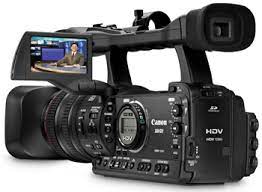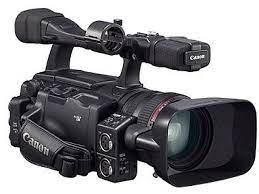Due videocamere che ampliano la gamma HD Canon dedicata al prosumer La Canon presenta due camcorders ad alta definizione con risoluzione di 1440x1080 (interlacciata). I due modelli, Canon XH G1 e la XH A1, presentano entrambe un triplo CCD ad 1/3-inch, hanno risoluzione nativa 16:9 e possono registrare a diversi frame rate inclusi 60i, 30p e 24p. A livello audio sono presenti gli attacchi per 2 jack audio XLR.
La Canon presenta due camcorders ad alta definizione con risoluzione di 1440x1080 (interlacciata). I due modelli, Canon XH G1 e la XH A1, presentano entrambe un triplo CCD ad 1/3-inch, hanno risoluzione nativa 16:9 e possono registrare a diversi frame rate inclusi 60i, 30p e 24p. A livello audio sono presenti gli attacchi per 2 jack audio XLR.
 L'obiettivo, non intercambiabile, è uno zoom HD 20x che utilizza in gran parte la stessa tecnologia delle lenti fotografiche Canon, usando lenti a cristallo di fluorite e vetri a bassa dispersione: ha 3 anelli, uno per la messa a fuoco, uno per lo zoom ed uno per il diaframma. Inoltre i 2 camcorder integrano uno stabilizzatore dell'immagine ottico evoluto e le otiiche possono mettere a fuoco instantaneamente perchè presentano un nuovo sensore di focalizzazione esterno.
L'obiettivo, non intercambiabile, è uno zoom HD 20x che utilizza in gran parte la stessa tecnologia delle lenti fotografiche Canon, usando lenti a cristallo di fluorite e vetri a bassa dispersione: ha 3 anelli, uno per la messa a fuoco, uno per lo zoom ed uno per il diaframma. Inoltre i 2 camcorder integrano uno stabilizzatore dell'immagine ottico evoluto e le otiiche possono mettere a fuoco instantaneamente perchè presentano un nuovo sensore di focalizzazione esterno.
Per i prezzi, la XH G1 è in vendita a 7000 dollari, mentre la XH A1 a 4000.
In particolare:
|
Con l’introduzione di XH A1 e XH G1, due videocamere con 3 CCD da 1,67 megapixel ad alta definizione, Canon offre la qualità professionale ad alta risoluzione alla nuova generazione di operatori video. |
|
|
|
Canon offre una nuova gamma versatile di videocamere HD complementari all’ammiraglia XL H1, ideale per registi indipendenti, reporter di cronaca, case produttrici e studi televisivi. Le nuove videocamere rafforzano la presenza di Canon nel mercato emergente del video ad alta definizione: XH A1 è caratterizzata da riprese a 25 fotogrammi (25F) e impostazioni dedicate Cine per ottenere l’aspetto e il feeling di un film. XH G1, che incorpora un’addizionale connettività con standard da studio, costituisce invece una nuova categoria di prodotto. Qualità ad alta definizione Stabilizzatore ottico Super Range
"We introduced the top-end model [the XL H1]," said Mitchell Glick, Assistant Manager of Product Marketing, Video Division at Canon USA, "and now we're filling in the rest of the line with entry-level and prosumer." Both the XH G1 and XH A1 are likely to be hits with the prosumer independent film market. The XL H1 has already received accolades from professionals, prosumers, and student filmmakers, thought the $9.000 MSRP was prohibitive.
A front view of the Canon XH A1 The XH G1 and XH A1 feature three 1/3-inch CCD sensors, each a native 16:9 with a resolution of 1440 x 1080. A rear view of the Canon XH G1 (left) and close up of the jack pack on back (right) Canon’s choice to continue using HDV as their high definition format is not surprising. HDV has found fairly wide acceptance and compatibility in the market after its introduction in 2003. Originally developed by JVC, Sony and Canon quickly joined on as partners. In September of last year Canon unveiled their first HDV camcorder, the XL H1 (MSRP $8.999). The XH G1 and XH A1 feature the same DIGIC DV II processor found on the XL H1. This processor offers a built-in noise reduction system, as well as more accurate color and tonal response than the first version of the DIGIC DV. Perhaps the most notable new feature for professionals is an improved SD/HD-SDI, which is available only on the XH G1 as part of the jack pack. The new design embeds not only the video signal and timecode, but now the audio as well. The Canon XL H1’s SD/HD-SD1 required a separate connection for the audio signal. The XH G1 will still offer a separate SMPTE Timecode in/out (with an external switch to toggle between in/out) and Genlock input. Both the SD and HD-SDI outputs comply with SMPTE standards, so the embedded information is expected to be accessible to existing hardware. As Canon explained, these features are clearly aimed at the higher end news gathering and film markets, and most small business and prosumer users won't likely need them.
The second clear market for the XH G1, is the often forgotten but equally important market of news gathering professionals and event videographers. It's a market that has always been attracked to the mid-sized prosumer camcorder, consistently more than any other group. While features like 24P and endless picture controls appeal to indie filmakers, a large number of videographers just need a highly functional, durable camcorder that is able to shoot good video, fast and efficiently. The Sony PD170 and PD150, the predecesor to the FX1 and it's high end Z1 was notorious in this market, carrying the entire market for years. Canon's XL series has struggled a bit with the news gathering and event videographers crowd becuase of it's akward design. However, Canon has worked very hard on XH G1 and XH A1 to appeal to this market with a tight, durable and portable body design, many accessiby controls, and featuers especially designed at this market. The ability to deliver superior video performance, control and durability (if it's close to the durability of the very strong XL H1) may provide incredibly stiff competition for the Sony models in this price range for the ENG and event crowd. Clearly, customization has been a priority for Canon in the development of these new camcorders, and both the XH G1 and the XH A1 offer some intriguing new features along these lines. The camcorders will store up to 9 custom pre-sets in the camcorder’s internal memory, including a custom LCD display that shows only the information that the user defines. These settings – up to 20 variables – can also be saved as a special file to SD card and imported to other XH G1s and XH A1s. Unfortunately, the XL H1 will not recognize this file type. There are also two custom keys, just as there are on the XL H1. Canon XH A1's left side (above) and close up details (below)
Images can be viewed on a 2.8-inch widescreen LCD (207K resolution) or a 0.57-inch color electronic viewfinder (269K resolution). The LCD has been completely overhauled from the GL2. It now stores under the handle and flips out to the left, rotating on a round hinge. The XH G1 and XH A1 both use an enclosed battery design, which may seem alarmingly short-sighted at first glance. However, Canon assured that the battery cavity is designed is to accommodate the largest battery that they make, making it possible to shoot up to 7 hours of video. The manual control suite is largely similar to the XL H1. There is an auto mode, full manual mode, and aperture and shutter priority modes. The gain can be manually adjusted up to +36dB (up from +18 on the Xl H1). This increased gain range, said Canon, was aimed at news gatherers and law enforcement who must often work under extreme low light conditions with little regard for picture grain. There are also two built-in ND filters, at 1/6 and 1/32. Another one of the upgraded features of the XH G1 and XH A1 is Instant AF, a new focusing system that decreases focal time and increases focal effectiveness. The method, which Canon claims to be far superior to any they have used before or is in use by other companies, works by implementing an entirely separate, external sensor that measures camera-to-subject distance first using contrast, to get the focus “in the ballpark.” It then needs to drive the focus lens only a small degree to fine tune it. When asked how well it worked in the dark, Canon responded that it would need a sufficient amount of contrast between subjects in order to focus effectively. The zoom controls are located in the roughly the same places as the XL H1, one on the grip, one on the lens (as a ring), and one on top of the handle. Also like the XL H1, speeds on the XH G1 and XH A1 can be set to a pressure-sensitive variable mode, or set to a fixable constant speed. A dedicated zoom speed dial allows you to select from a range of 1 to 36 speeds. The XH G1 and XH A1 offer a number of audio controls, as well. Both camcorders offer two XLR terminals that provide phantom power. Each channel has audio level adjustment via external dials. The camcorders also ship with an external microphone holder, similar to one found on the XL H1, that attaches to the upper part of the body. This attachment can be removed if the user opts for the built-in stereo mic, located on the front end of the handle. Still features on the XH G1 and XH A1 match those of the Xl H1. There are two 16:9 aspect ratio sizes, 1920 x 1080 (2MP) and 848 x 480, and two 4:3 aspect ratio sizes, 1440 x 1080 and 640 x 480. Like the Xl H1, the new camcorders will offer Continuous Shooting, Hi-Speed Continuous Shooting, Bracketing, three metering modes, and can take a Canon Speedlite flash using the hot accessory shoe. Stills can taken in video mode or still mode to take advantage of the different gamma spaces. Canon also announced that the XH G1 and XH A1’s entrance into the market will be accompanied by an updated version of their Console software (not included). Console Image Control 1.1, whose predecessor was released in tandem with the XL H1, allows video to be captured directly to a PC hard drive. Through the PC’s interface, nearly all the camcorder’s functions can be controlled, as well as monitoring performance through a Vectrascope and waveform monitor. The Canon XH A1 will be released in late October for an MSRP of $3.999, followed by the XH G1 in mid-November at an MSRP of $6999. These new camcorders triple the number of HDV models Canon has on the market. |

 Entrambe le videocamere beneficiano di un sensore d’immagine a 3 CCD da 1,67 megapixel introdotto per la prima volta nella videocamera ammiraglia XL H1. Registrando filmati ad alta definizione HDV1080i (1440x1080 pixel), la risoluzione più elevata possibile con questo standard, si garantisce un risultato sorprendente. Lo standard video HD fornisce inoltre la possibilità di ottenere video in ad alta definizione sulle cassette MiniDV, economiche e facilmente reperibili.
Entrambe le videocamere beneficiano di un sensore d’immagine a 3 CCD da 1,67 megapixel introdotto per la prima volta nella videocamera ammiraglia XL H1. Registrando filmati ad alta definizione HDV1080i (1440x1080 pixel), la risoluzione più elevata possibile con questo standard, si garantisce un risultato sorprendente. Lo standard video HD fornisce inoltre la possibilità di ottenere video in ad alta definizione sulle cassette MiniDV, economiche e facilmente reperibili.  Instant AF
Instant AF DIGIC DV II
DIGIC DV II Connessioni a standard industriale
Connessioni a standard industriale Batteria interna
Batteria interna































































































































